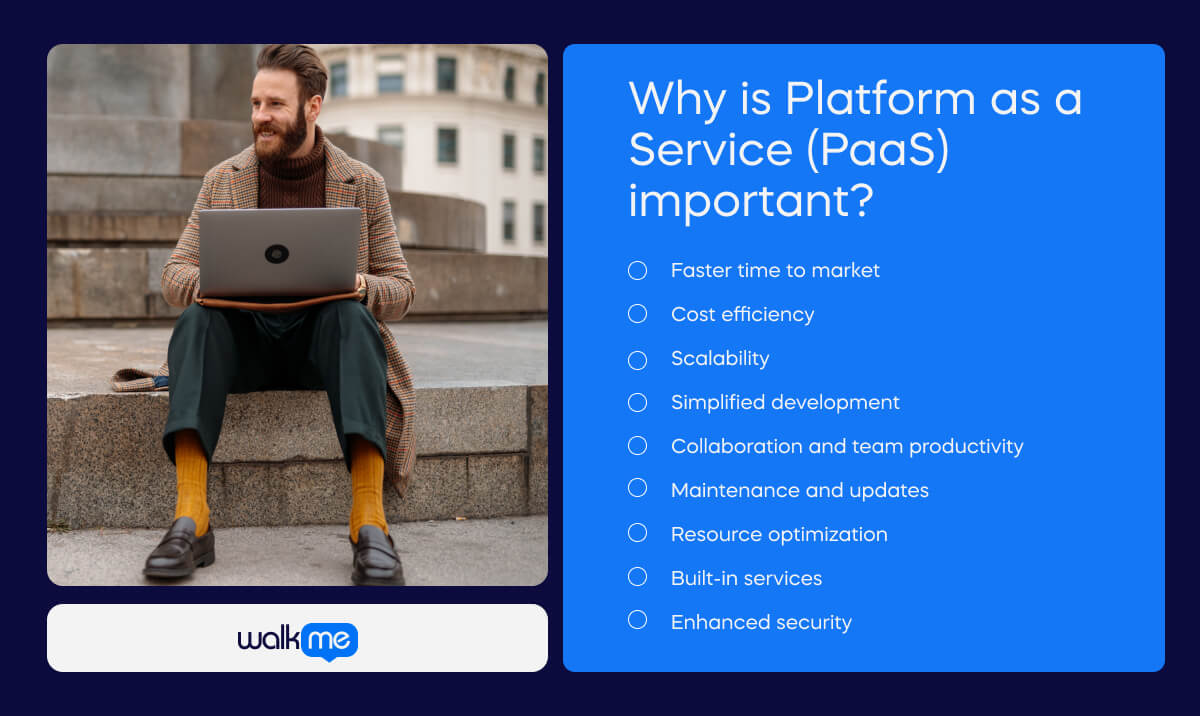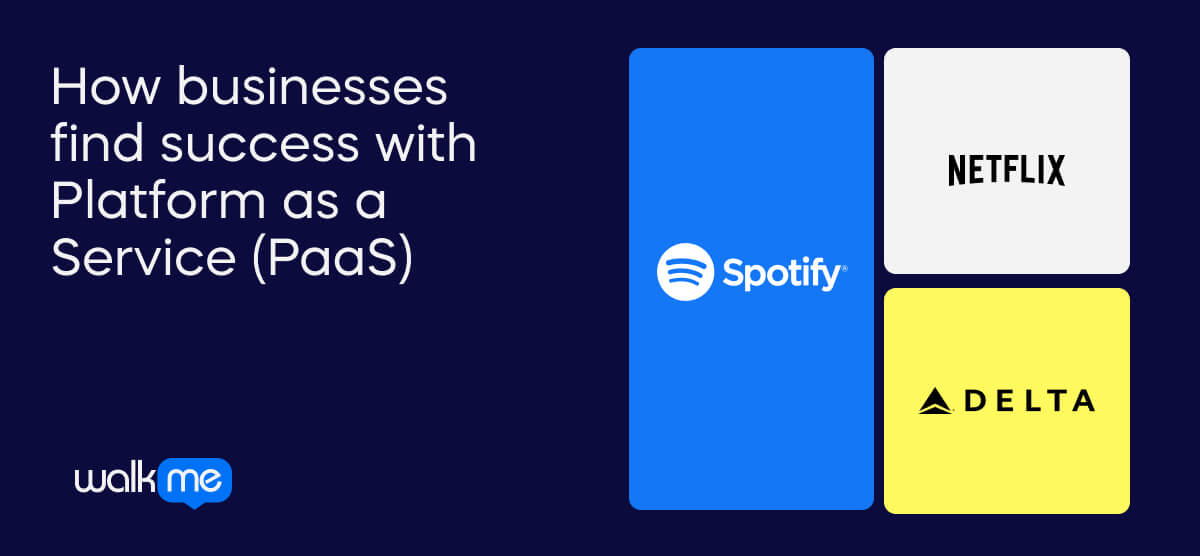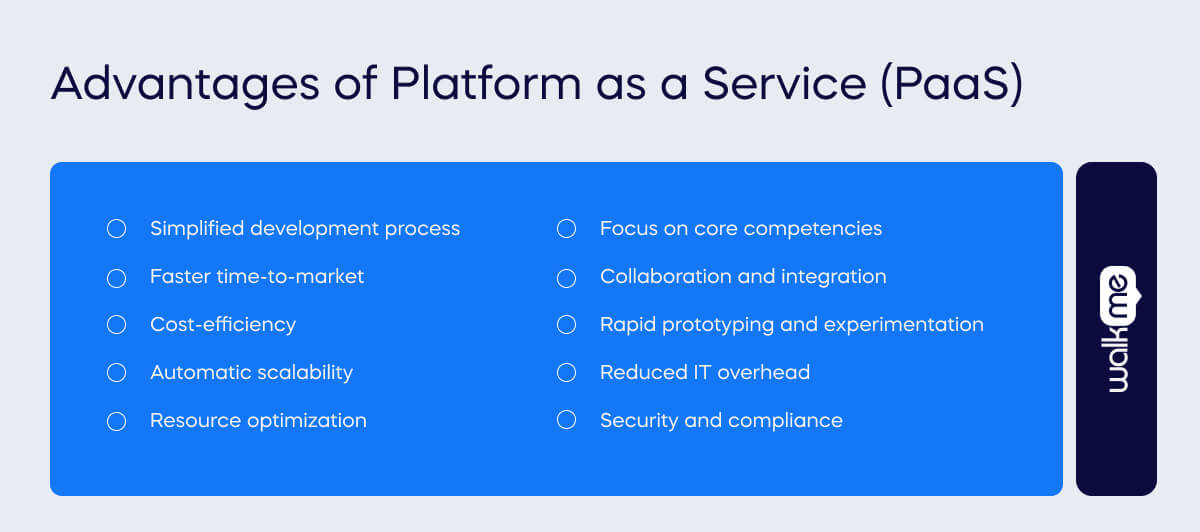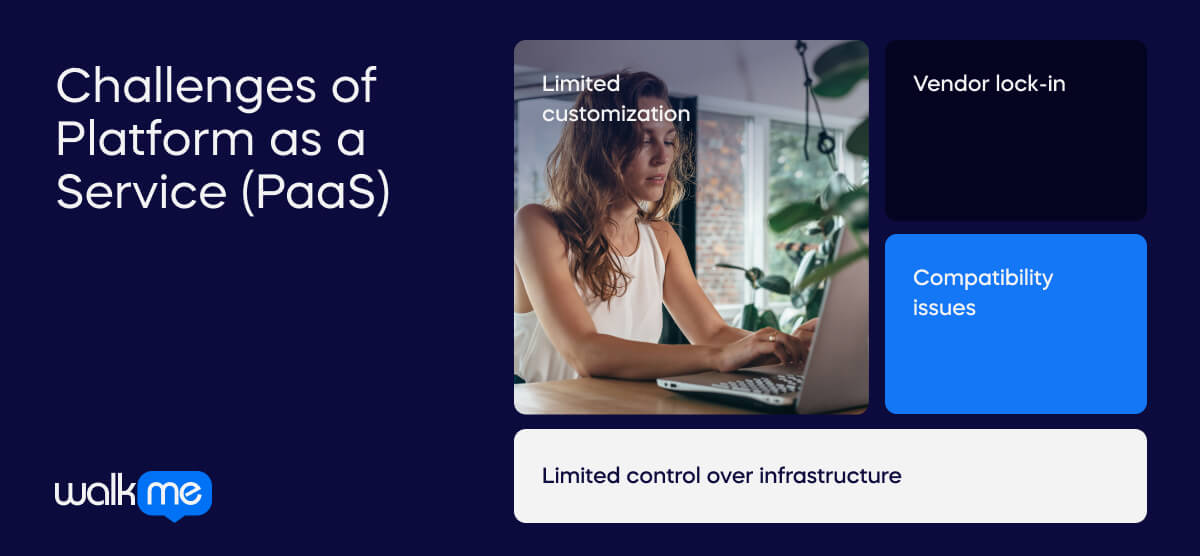Platform as a Service (PaaS)

Table of contents
Platform as a Service (PaaS) is a cloud computing service model that provides a platform allowing customers to develop, run, and manage applications without dealing with the complexity of building and maintaining the underlying infrastructure.
In a PaaS environment, the cloud service provider offers a comprehensive set of digital tools, services, and runtime environments that enable developers to focus on writing code and creating applications.
PaaS is positioned between Infrastructure as a Service (IaaS) and Software as a Service (SaaS) in the cloud computing service stack.
While IaaS provides the fundamental computing infrastructure (virtual machines, storage, networking), and SaaS offers complete software applications, PaaS abstracts away the complexity of infrastructure management while providing a platform for developing and deploying applications.
This abstraction allows developers to focus on writing code and building functionality, accelerating the development process.
Platform as a Service (PaaS) offers a range of functionalities to developers, making it easier for them to build, deploy, and manage applications without dealing with the complexities of the underlying infrastructure.
These functionalities collectively enable developers to focus on writing code and building applications, while the PaaS platform takes care of the underlying infrastructure and operational aspects.
PaaS thus accelerates the development lifecycle and promotes a more streamlined and efficient development process.
Businesses across the globe are readily recognizing these benefits. Gartner analysts said that over 85% of organizations will embrace a cloud-first principle by 2025 and cannot fully execute their digital strategies without using cloud-native architectures and technologies.
Contextualizing PaaS for users
PaaS services multiple stakeholders within a business, enabling them to work more effectively and progress at scale. Here’s an overview.
Developers
For developers, PaaS is like a ready-made development environment in the cloud.
They can access a set of tools, frameworks, and runtime environments to build and deploy applications without worrying about server configurations or infrastructure maintenance.
PaaS accelerates the development process by automating tasks like deployment, scaling, and maintenance.
IT administrators
IT administrators benefit from PaaS as it reduces the burden of infrastructure management.
They don’t need to worry about provisioning servers, configuring networking, or maintaining operating systems. Instead, they can focus on optimizing the overall application environment and ensuring security.
Business owners
From a business perspective, PaaS offers faster time-to-market for applications.
It reduces development costs by eliminating the need for extensive infrastructure investments and ongoing maintenance.
PaaS enables businesses to be more agile and responsive to changing market demands.
An all-encompassing solution
As you can see, PaaS simplifies the development and deployment process by providing a comprehensive platform for building applications.
It allows users to focus on creating software solutions while the cloud provider manages the underlying infrastructure, striking a balance between control and abstraction in the cloud computing service stack.
Platform as a Service (PaaS) serves a vital role in the wider scheme of digital transformation, driving positive change in business by streamlining development, automating operations, and fostering innovation.
Why is Platform as a Service (PaaS) important?

Platform as a Service (PaaS) is a crucial component of modern IT landscapes, offering numerous benefits for businesses and developers alike.
Let’s explore the significance of PaaS, delving into its role in accelerating development, reducing costs, and providing a scalable and secure environment for applications.
Faster time to market
PaaS provides a ready-to-use platform with built-in infrastructure, tools, and services, allowing developers to focus on coding and application development rather than dealing with the complexities of setting up and managing the underlying infrastructure.
This accelerates the development process and enables faster time-to-market for applications.
Cost efficiency
PaaS eliminates the need for organizations to invest heavily in and manage their own infrastructure. It operates on a pay-as-you-go model, where users only pay for the resources and services they consume.
This can save money by avoiding upfront infrastructure costs and reducing ongoing maintenance expenses.
Scalability
PaaS platforms are designed to scale easily based on demand. They provide automated scaling features that allow applications to handle increased workloads without manual intervention.
This scalability ensures that applications can grow seamlessly as the user base or workload expands.
Simplified development
PaaS abstracts away many of the complexities of infrastructure management, allowing developers to focus on writing code and building features.
This simplification leads to more efficient development processes and allows teams to concentrate on innovation rather than dealing with the intricacies of hardware and software configurations.
Collaboration and team productivity
PaaS often includes collaboration tools and integrated development environments (IDEs) that facilitate teamwork.
Developers can work together in a more streamlined manner, share code, and collaborate on projects, leading to increased productivity and efficiency within development teams.
Maintenance and updates
PaaS providers handle the underlying infrastructure, operating systems, and middleware maintenance and updates.
This allows developers to focus on improving their applications rather than spending time on routine maintenance tasks, ensuring that the software is always running in the latest and most secure environment.
Resource optimization
PaaS platforms often include features for automatic resource allocation and optimization.
This ensures that resources are utilized efficiently, and organizations do not have to worry about overprovisioning or underprovisioning their infrastructure.
Built-in services
PaaS platforms have various built-in services, such as databases, messaging queues, authentication, etc.
This eliminates the need for developers to build these components from scratch, saving time and effort in the development process.
Enhanced security
PaaS providers typically implement security best practices and offer features like data encryption, identity management, and compliance certifications.
Leveraging these built-in security measures can enhance the overall security posture of applications hosted on PaaS platforms.
Use Cases for Platform as a Service (PaaS)
We’ve established that PaaS benefits several business functions and boasts many demonstrable advantages.
Now, let’s examine how Platform as a Service (PaaS) can be implemented in the workplace and explore how specific companies leverage its capabilities to enhance their operations.
Platform as a Service (PaaS) in business
Here are several scenarios where PaaS is actively utilized in business:
Application development and deployment
PaaS is extensively used to streamline the development process. Developers leverage PaaS platforms to access a complete development environment with tools, libraries, and runtime support.
Features like version control, continuous integration, and deployment tools are integrated into PaaS, facilitating faster and more efficient application development.
Web hosting and content management
PaaS is commonly employed for web hosting and content management systems. Users can deploy websites and web applications without dealing with the intricacies of server configuration and maintenance.
Content management platforms built on PaaS allow users to focus on content creation and updates, while the platform handles the underlying infrastructure.
Database management
PaaS offers database services that simplify database management. Users can deploy, manage, and scale databases without dealing with the complexities of server administration.
These services include features such as automatic backups, data replication, and seamless scaling based on demand.
Internet of Things (IoT) solutions
PaaS plays a crucial role in developing and managing IoT applications. It provides the necessary infrastructure and tools for processing and analyzing data generated by IoT devices.
PaaS platforms enable seamless integration with various IoT components, supporting the development of scalable and efficient IoT solutions.
Mobile application development
PaaS is widely used for mobile app development, providing a unified environment for building, testing, and deploying applications across different platforms.
Mobile app developers can leverage PaaS to access development frameworks, SDKs, and deployment tools, simplifying the complexities associated with cross-platform development.
How businesses find success with Platform as a Service (PaaS)

Organizations across various sectors have successfully implemented Platform as a Service, showcasing the diverse ways it has improved efficiency, cost-effectiveness, and other notable benefits. Here are some notable examples:
Netflix
Netflix relies on PaaS for its content delivery infrastructure.
By utilizing cloud-based PaaS solutions, such as AWS Elastic Beanstalk, Netflix can dynamically scale its resources based on demand, ensuring a smooth streaming experience for users worldwide.
PaaS abstracts the complexities of infrastructure management, allowing Netflix to focus on content delivery innovations and efficiently manage costs by optimizing resource allocation.
Spotify
Spotify employs PaaS platforms like Google App Engine to enhance its development processes.
This allows Spotify’s development teams to concentrate on creating and improving features without being burdened by the intricacies of infrastructure management.
PaaS facilitates continuous integration and deployment, enabling Spotify to rapidly roll out new features and updates.
This agile approach has contributed to Spotify’s ability to stay competitive in the dynamic music streaming industry.
Delta Airlines
Delta Airlines employs PaaS to enhance its digital customer experience.
By utilizing PaaS solutions like Salesforce App Cloud, Delta can rapidly develop and deploy applications for services such as online check-in, mobile boarding passes, and personalized travel recommendations.
This streamlines the passenger journey, improves customer satisfaction, and allows Delta to adapt quickly to industry changes by continuously innovating its digital services.
PaaS vs. IaaS vs. SaaS
Infrastructure as a Service (IaaS), Platform as a Service (PaaS), and Software as a Service (SaaS) are three distinct cloud computing service models, each offering different levels of abstraction and management responsibilities.
Here are the key differences between IaaS, PaaS, and SaaS:
| Definition | Management Responsibility | Use Cases | |
| PaaS | Provides a higher-level platform that abstracts away the underlying infrastructure. It includes development frameworks, databases, middleware, and other tools to facilitate application development and deployment. | Users focus primarily on developing and deploying applications without managing the underlying infrastructure. PaaS providers handle tasks such as operating system updates, runtime environments, and scaling. | Ideal for developers who want to streamline the application development process, as it eliminates the need to manage infrastructure details. It is commonly used for building and deploying web and mobile applications. |
| IaaS | Provides virtualized computing resources over the internet. It includes virtual machines, storage, and networking, allowing users to build and manage their own infrastructure. | Users have control over the operating systems, applications, and runtime, as well as the configuration of networking components. This means they manage and maintain the entire infrastructure stack, including security updates and patches. | Suitable for users who need scalable and flexible infrastructure without the burden of physical hardware management. It is often used for hosting applications, development environments, and storage solutions. |
| SaaS | Delivers software applications over the internet on a subscription basis. Users access the software through a web browser without the need for installation or maintenance. | Users have little control over the underlying infrastructure, operating systems, or application code. The software provider manages everything, including updates, security, and scalability. | Suitable for end-users or businesses that need access to specific software applications without the hassle of installation and maintenance. Examples include email services, customer relationship management (CRM) tools, and collaboration platforms. |
Advantages of Platform as a Service (PaaS)

Platform as a Service (PaaS) offers several advantages, making it a valuable choice for developers, organizations, and businesses. Some key advantages of PaaS include:
Simplified development process
PaaS abstracts away the complexities of infrastructure management, allowing developers to focus solely on writing code and building applications.
This simplifies the development process, reducing the time and effort required to bring applications to market.
Faster time-to-market
With PaaS, developers can leverage pre-built components, development frameworks, and ready-to-use services, speeding up the development lifecycle.
This results in faster time-to-market for applications and services.
Cost-efficiency
PaaS eliminates the need for organizations to invest in and maintain their own infrastructure.
This can result in cost savings, as users pay for the resources and services they consume on a pay-as-you-go basis, avoiding upfront capital expenditures.
Automatic scalability
PaaS platforms often provide automatic scalability, allowing applications to scale up or down based on demand.
This ensures optimal performance during peak usage periods while avoiding overprovisioning during periods of lower demand.
Resource optimization
PaaS abstracts the underlying infrastructure, allowing for efficient resource utilization.
Developers do not need to worry about managing servers, storage, or networking, leading to better resource optimization and cost-effectiveness.
Focus on core competencies
PaaS enables organizations to focus on their core competencies and business objectives, rather than getting bogged down by infrastructure management.
This allows for greater innovation and differentiation in the marketplace.
Collaboration and integration
PaaS provides a collaborative environment where multiple developers can work together seamlessly.
It also supports integration with other cloud services, APIs, and external systems, facilitating a more connected and interoperable ecosystem.
Rapid prototyping and experimentation
PaaS allows for rapid prototyping and experimentation, as developers can quickly spin up environments, test new features, and iterate on applications without requiring extensive setup and configuration.
Reduced IT overhead
Organizations using PaaS benefit from reduced IT overhead, as the responsibility for infrastructure management, maintenance, and updates is shifted to the PaaS provider.
This allows internal IT teams to focus on strategic initiatives rather than routine maintenance tasks.
Security and compliance
PaaS providers often implement robust security measures and compliance standards. By leveraging these platforms, organizations can benefit from the security expertise of the PaaS provider, ensuring a secure environment for their applications and data.
Challenges of Platform as a Service (PaaS)

While PaaS offers several advantages, there are also potential drawbacks to consider:
Limited customization
PaaS platforms often provide a predefined set of tools, frameworks, and services. This can limit the level of customization available to developers, especially when compared to Infrastructure as a Service (IaaS) or on-premises solutions.
Vendor lock-in
Adopting a specific PaaS platform may result in vendor lock-in, making it challenging to migrate applications to another platform or back to an on-premises environment. This can limit flexibility and increase dependence on a particular provider.
Compatibility issues
Applications developed on a PaaS platform may face compatibility issues when migrating to different environments. This is especially true if the PaaS provider uses proprietary technologies or unique APIs.
Limited control over infrastructure
PaaS abstracts much of the underlying infrastructure, which can be an advantage but may also be a challenge for organizations requiring fine-grained control over the operating system, networking, or security configurations.
Platform as a Service: A win for all
Platform as a Service (PaaS) plays a transformative role in the digital landscape. It has emerged as a strategic imperative that is driving IT transformation.
It is being rapidly adopted worldwide – research from McKinsey reveals that most executives they spoke to in Africa have transitioned to a cloud service, with workloads in a public cloud such as PaaS.
Such information only highlights the fact that PaaS provides a platform and environment to allow developers to build applications and services over the internet.
This has fostered efficiency by eliminating the complexity of building and maintaining the infrastructure typically associated with developing and launching an app.
Moreover, PaaS has been instrumental in driving innovation. It offers a variety of services to assist in the development, testing, and deployment of applications. This allows businesses to adapt quickly to changing market conditions, fostering a continual improvement culture.
As we delve deeper into the interconnected concepts beyond PaaS, we encounter related terms such as Infrastructure as a Service (IaaS) and Software as a Service (SaaS). These are integral components in the broader narrative of organizational development.
Together with PaaS, they form the triumvirate of cloud computing services that revolutionize business operations.
Whether you’re a developer looking to streamline your workflows, a manager seeking to drive operational efficiency, or a business leader aiming to foster innovation, understanding the potential of PaaS can be a game-changer.